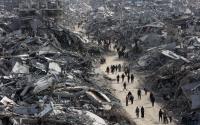29 September 2005The Independent
Arctic sea ice has melted to a record low this month, prompting fears that the entire polar ice cap may disappear within decades.
Satellite images of the northern hemisphere's floating sea ice show that the area of ocean covered by the ice during this month was the lowest ever observed by scientists.
It is the fourth consecutive summer that the area covered by the sea ice in the Arctic has shrunk below even the long-term decline, which began at least as far back as the late 1970s.
A gradual loss of sea ice has taken place for a quarter of a century but scientists believe they may be witnessing an acceleration in the melting process because of climate change and a process of "positive feedback" causing a vicious cycle of melting and warming.
The latest figures were released yesterday by the US National Aeronautics and Space Administration (Nasa) and the National Snow and Ice Data Centre at Colorado University, which described the loss of September ice as a "stunning reduction".
As predicted by The Independent, the sea ice coverage this month fell about 20 per cent below the long-term average.
For the past four years, the loss of summer sea ice in the Arctic has been equivalent to an area of 500,000 square miles - roughly twice the size of Texas or Iraq.
Ted Scambos, the Colorado University scientist who led the study, said a reasonable explanation for the dramatic loss of sea ice is climate change.
"Since the 1990s, the melting and retreat trends are accelerating and the one common thread is that the Arctic temperatures over the ice, ocean and surrounding land have increased in recent decades," Dr Scambos said.
"Normally a summer low is followed by a rebound back to more normal levels but this has not occurred for the past four summers," said Walt Meier of the National Snow and Ice Data Centre.
"With four consecutive years of low summer ice extent, confidence is strengthening that a long-term decline is under way," Dr Meier said.
"Having four years in a row with such low ice extents has never been seen before in the satellite record. It clearly indicates a downward trend, not just a short-term anomaly," he said.
Mark Serreze said that the loss of Arctic sea ice is likely to make global warming worse because more ocean is exposed to the warming effects of the sun.
"It's likely that we will find this to be the case in coming decades, because of something called a positive feedback loop, in which an initial warming sets in motion a chain of events that causes further warming. The Arctic is very susceptible to this," Dr Serreze said. "Sea ice is white and, therefore, reflects a lot of the sun's energy back into space, whereas dark, open ocean absorbs a lot more energy ... So, a warming Arctic leads the planet to absorb more energy. That, in turn, could cause global average temperatures to rise still more," he said.
Average surface temperatures in the Arctic this summer were between 2C and 3C warmer than average across the Arctic Ocean.
The famous north-west passage through the Canadian Arctic from Europe to Asia was largely free of ice except for a 60-mile swath of scattered ice floes.
The north-east passage which runs north of Russian Siberia was completely free of ice for the period 15 August to 28 September, the Snow and Ice Data Centre said.
"The sea-ice cover seems to be rapidly changing and the best explanation for this is rising temperatures," Dr Serreze said. "Something has fundamentally changed here, and the best answer is warming," he said.
Sea ice in the Arctic expands and recedes each winter and summer but scientists found for the first time that a natural rebound did not occur last winter and that the start of the melting period in spring occurs earlier than average.
It has meant that ice that has remained stable for many years - so called multiyear ice - has begun to melt, according to the scientists' findings.






